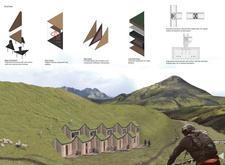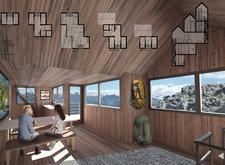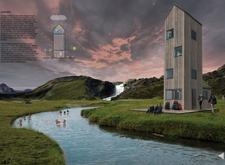5 key facts about this project
# Architectural Analysis Report: Iceland Trekking Cabin Project
## Overview
Located in Iceland's rugged terrain, the Iceland Trekking Cabin is an architectural design that merges traditional building techniques with contemporary ecological principles. The project is intended to provide a functional and sustainable refuge for outdoor enthusiasts, reflecting both the cultural heritage of the region and its natural landscape. The cabin's vertical typology minimizes its spatial footprint while adapting to the contours of the surrounding environment.
### Spatial Strategy
The cabin employs a vertically oriented design that accommodates a variety of user activities without compromising the integrity of the landscape. The stacked layout includes communal and private spaces, enabling functionality that supports both social interaction and individual privacy. Integrating elements inspired by volcanic basalt, the architecture resonates with local geology and emphasizes a strong connection to its surroundings.
### Material Considerations
Innovative material selection is a core aspect of the design, prioritizing durability and energy efficiency. Treated wood cladding enhances the aesthetics while offering resilience against the harsh Icelandic climate. Prefabricated wall panels, equipped with moisture barriers, improve insulation and adhere to sustainability goals. The turf roofing system, featuring a charcoal membrane for rainwater filtration, demonstrates commitment to environmental stewardship. Finally, structural components such as engineered steel stilt systems provide stability on uneven terrain while facilitating efficient transport and assembly on-site.
### User Experience
Interior layouts prioritize comfort and practicality, offering spaces for communal engagement and private rest. Designated areas for dining, relaxation, and utility ensure that the diverse needs of trekkers are met. Large windows facilitate visual connectivity with the breathtaking landscape, enhancing the overall experience for users by bringing the outdoor environment indoors. The combination of functional design and aesthetic consideration underscores the cabin’s role as a modern shelter within Iceland's distinctive context.






















































